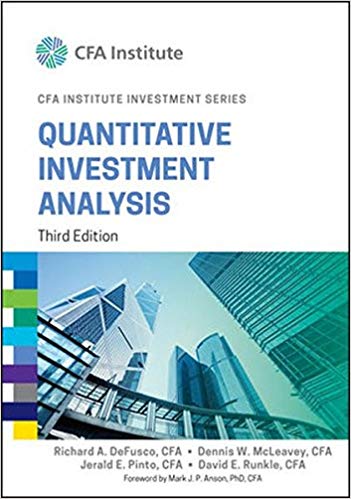Adele Chiesa is a money manager for the Bianco Fund. She is interested in recent findings showing
Question:
Excess stock marker return t
= a0 + a1 default spread t-1 + a2 Term spread t-1 + a3 Pres party dummy t-1 + e t
Default spread is equal to the yield on Baa bonds minus the yield on Aaa bonds. Term spread is equal to the yield on a 10-year constant-maturity US Treasury index minus the yield on a 1-year constant-maturity US Treasury index. Pres party dummy is equal to 1 if the US President is a member of the Democratic Party and 0 if a member of the Republican Party.
Chiesa collects 432 months of data (all data are in percent form, i.e., 0.01 = 1 percent). The regression is estimated with 431 observations because the independent variables are lagged one month. The regression output is in Exhibit 1. Exhibits 2 through 5 contain critical values for selected test statistics.
-1.png)
Number of observations.............................................431
Test statistic from Breusch-Pagan (BP) test.....................7.35
R2.....................................................................0.053
Adjusted R2.........................................................0.046
Durbin-Watson (DW) ..............................................1.65
Sum of squared errors (SSE)....................................19,048
Regression sum of squares (SSR).................................1,071
An intern working for Chiesa has a number of questions about the results in Exhibit 1:
Question 1 How do you test to determine whether the overall regression model is significant?
Question 2 Does the estimated model conform to standard regression assumptions?
For instance, is the error term serially correlated, or is there conditional heteroskedasticity?
Question 3 How do you interpret the coefficient for the Pres party dummy variable?
Question 4 Default spread appears to be quite important. Is there some way to assess the precision of its estimated coefficient? What is the economic interpretation of this variable?
After responding to her intern's questions, Chiesa concludes with the following statement: "Predictions from Exhibit 1 are subject to parameter estimate uncertainty, but not regression model uncertainty."
-2.png)
EXHIBIT 3
Table of the Student's t-Distribution.............(One-Tailed Probabilities for df = ˆž)
P...................................................................t
0.10............................................................1.282
0.05............................................................1.645
0.025...........................................................1.960
0.01............................................................2.326
0.005...........................................................2.576
-3.png)
-4.png)
In response to Question 4, the 95 percent confidence interval for the regression coefficient for the default spread is closest to:
A. 0.13 to 5.95.
B. 1.72 to 4.36.
C. 1.93 to 4.15.
Step by Step Answer:

Quantitative Investment Analysis
ISBN: 978-1119104223
3rd edition
Authors: Richard A. DeFusco, Dennis W. McLeavey, Jerald E. Pinto, David E. Runkle





